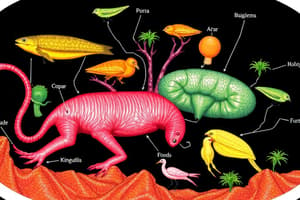Podcast
Questions and Answers
Biological classification was first proposed by Aristotle who used simple morphological characteristics to classify plants into trees, shrubs and herbs. He also classified animals into two groups, those which had _____ blood and those that did not.
Biological classification was first proposed by Aristotle who used simple morphological characteristics to classify plants into trees, shrubs and herbs. He also classified animals into two groups, those which had _____ blood and those that did not.
red
The Five Kingdom Classification proposed by R.H. Whittaker (1969) distinguished between prokaryotes and _____.
The Five Kingdom Classification proposed by R.H. Whittaker (1969) distinguished between prokaryotes and _____.
eukaryotes
The Five Kingdom Classification system, which includes Monera, Protista, Fungi, Plantae, and Animalia, was proposed by _____.
The Five Kingdom Classification system, which includes Monera, Protista, Fungi, Plantae, and Animalia, was proposed by _____.
R.H. Whittaker
Match the Classification System with the Taxonomist who proposed it:
Match the Classification System with the Taxonomist who proposed it:
In earlier classification systems, the character that unified diverse organisms like bacteria, fungi, mosses, ferns, etc., under 'Plants' was the presence of a _____ _____ in their cells.
In earlier classification systems, the character that unified diverse organisms like bacteria, fungi, mosses, ferns, etc., under 'Plants' was the presence of a _____ _____ in their cells.
The Five Kingdom Classification grouped prokaryotic bacteria and blue-green algae (cyanobacteria) into the Kingdom _____.
The Five Kingdom Classification grouped prokaryotic bacteria and blue-green algae (cyanobacteria) into the Kingdom _____.
In the Five Kingdom Classification, unicellular eukaryotic organisms like Chlamydomonas and Paramecium were placed in Kingdom _____.
In the Five Kingdom Classification, unicellular eukaryotic organisms like Chlamydomonas and Paramecium were placed in Kingdom _____.
Kingdom Protista brought together Chlamydomonas and Chlorella (previously in Plantae) with Paramoecium and Amoeba (previously in Animalia), the latter of which lack a _____ _____.
Kingdom Protista brought together Chlamydomonas and Chlorella (previously in Plantae) with Paramoecium and Amoeba (previously in Animalia), the latter of which lack a _____ _____.
What was a major limitation of the Two-Kingdom classification system regarding prokaryotes and eukaryotes?
What was a major limitation of the Two-Kingdom classification system regarding prokaryotes and eukaryotes?
How did the Two-Kingdom system handle unicellular and multicellular organisms?
How did the Two-Kingdom system handle unicellular and multicellular organisms?
Explain the issue with classifying Fungi in the Two-Kingdom system.
Explain the issue with classifying Fungi in the Two-Kingdom system.
Aristotle was the first to propose a biological classification system.
Aristotle was the first to propose a biological classification system.
What is the main purpose of biological classification?
What is the main purpose of biological classification?
Linnaeus introduced the two-kingdom classification, dividing all organisms into Kingdom _____ and Kingdom Animalia.
Linnaeus introduced the two-kingdom classification, dividing all organisms into Kingdom _____ and Kingdom Animalia.
True or False: In the Two-Kingdom system, lichens were included in the Plant Kingdom.
True or False: In the Two-Kingdom system, lichens were included in the Plant Kingdom.
Which of the following were the main criteria used by R.H. Whittaker for the Five Kingdom Classification? (Select all that apply)
Which of the following were the main criteria used by R.H. Whittaker for the Five Kingdom Classification? (Select all that apply)
Flashcards
Biological classification
Biological classification
Identifying differences among organisms and grouping them based on significant features and relationships.
Purpose of biological classification
Purpose of biological classification
The purpose is to organize vast numbers of known plants into categories for easier study.
Two kingdom classification
Two kingdom classification
Classified all organisms into two kingdoms- Kingdom plantae and kingdom animalia.
Kingdom Plantae
Kingdom Plantae
Signup and view all the flashcards
Kingdom Animalia
Kingdom Animalia
Signup and view all the flashcards
Limitation of two-kingdom system
Limitation of two-kingdom system
Signup and view all the flashcards
Two-kingdom system: Prokaryotes
Two-kingdom system: Prokaryotes
Signup and view all the flashcards
Two-kingdom system: Fungi
Two-kingdom system: Fungi
Signup and view all the flashcards
Two-kingdom system: Eukaryotes vs prokaryotes
Two-kingdom system: Eukaryotes vs prokaryotes
Signup and view all the flashcards
Five Kingdom Classification System
Five Kingdom Classification System
Signup and view all the flashcards
Five Kingdoms
Five Kingdoms
Signup and view all the flashcards
Main criteria for classification
Main criteria for classification
Signup and view all the flashcards
Early classification system
Early classification system
Signup and view all the flashcards
Character that untied the whole kingdom
Character that untied the whole kingdom
Signup and view all the flashcards
It brought together
It brought together
Signup and view all the flashcards
All prokaryotic organisms were gropued together under
All prokaryotic organisms were gropued together under
Signup and view all the flashcards
Merits of Five Kingdom Classification
Merits of Five Kingdom Classification
Signup and view all the flashcards
Five Kingdom Classification
Five Kingdom Classification
Signup and view all the flashcards
Five Kingdom Classification: Fungi and Protozoa
Five Kingdom Classification: Fungi and Protozoa
Signup and view all the flashcards
Study Notes
- Biological classification involves identifying differences among organisms and placing them into groups, reflecting significant features and relationships.
- Aristotle first proposed biological classification, using morphological characteristics to classify plants into trees, shrubs, and herbs.
- Aristotle classified animals into two groups based on the presence or absence of red blood.
- The purpose of biological classification is to organize known plants into categories for easier study.
Classification Systems
- Carolus Linnaeus proposed a 2-kingdom system, dividing organisms into Plantae and Animalia.
- Ernst Haeckel proposed a 3-kingdom system: Plantae, Protista, and Animalia.
- Copeland introduced a 4-kingdom system: Plantae, Protista, Monera, and Animalia.
- Whittaker proposed a 5-kingdom system: Plantae, Protista, Monera, Fungi, and Animalia.
- Carl Woese proposed a 6-kingdom system: Plantae, Protista, Monera, Fungi, Archaebacteria, and Animalia.
Two Kingdom Classification System
- Linnaeus classified all organisms into Kingdom Plantae and Kingdom Animalia.
- Kingdom Plantae included autotrophic, fixed organisms.
- Kingdom Animalia included motile, heterotrophic organisms.
Limitations of the Two-Kingdom System
- Unicellular and multicellular forms were grouped together despite organizational differences.
- Bacteria and cyanobacteria (prokaryotes) were included under plants.
- Lichens, symbiotic organisms, were included in plants.
- Fungi, non-photosynthetic heterotrophs, were included under Plantae.
- The system failed to distinguish between prokaryotes and eukaryotes.
Five Kingdom Classification System
- R.H. Whittaker proposed the five-kingdom classification in 1969.
- The five kingdoms defined by Whittaker are Monera, Protista, Fungi, Plantae, and Animalia.
- Criteria for classification included cell structure, thallus organization, mode of nutrition, reproduction, and phylogenetic relationships.
Key Points of Five Kingdom Classification
- Earlier systems grouped bacteria, blue-green algae, fungi, mosses, ferns, gymnosperms, and angiosperms under 'Plants.'
- A unifying characteristic that all organisms contain include cell walls in all cells.
- The system grouped together prokaryotic bacteria and eukaryotic blue-green algae.
- Unicellular and multicellular organisms like Chlamydomonas and Spirogyra were grouped together under algae.
- Fungi have chitin in their walls, while green plants have cellulosic cell walls. Fungi were placed in a separate kingdom (Kingdom Fungi) when wall composition was considered.
- All prokaryotic organisms were grouped under Kingdom Monera.
- Unicellular eukaryotic organisms were placed in Kingdom Protista.
- Kingdom Protista includes Chlamydomonas and Chlorella, which were previously placed in Algae within Plants, and Paramecium and Amoeba which were previously placed in the animal kingdom.
Merits of Five Kingdom Classification
- Exhibits phylogenetic relationships between groups of organisms.
- Prokaryotes are classified in a separate kingdom based on genetic, cellular, reproductive, and physiological differences.
- Fungi were grouped under a separate kingdom, and protozoa were excluded from kingdom Animalia.
Studying That Suits You
Use AI to generate personalized quizzes and flashcards to suit your learning preferences.




